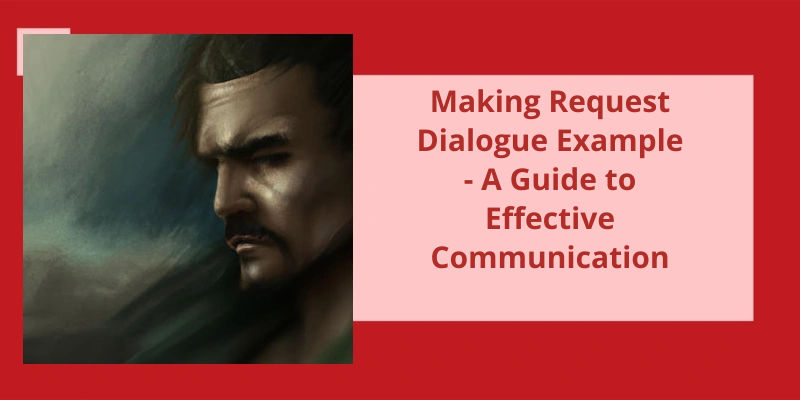Requesting something from someone can be a daunting task, especially if the request is something that they may not necessarily want to do or if they’re busy with their own tasks. However, there are various ways in which one can make a request without coming across as demanding or pushy. Using polite phrasing and showing genuine gratitude and appreciation for any help received can go a long way in making the other person feel valued, respected, and more likely to agree to the request. Some common phrasing examples of making requests include "May I ask you to.?", "Would you mind helping me with.?", and "Would it be possible to.?". By utilizing these polite phrasings and being clear and concise about the request, it’s possible to effectively communicate and make requests while maintaining positive relationships with others.
What Are the Two Types of Making Request?
Both types of requests have their own unique format and are used in different situations. Direct requests are usually more straightforward, where the speaker directly asks for something they need or want. On the other hand, indirect requests involve a bit more finesse and are used when the speaker wants to ask for something indirectly.
Direct requests are usually made by using imperative verbs like “Give me,” “Bring me,” or “Help me.”. These kinds of requests are often used when the speaker needs something urgently or wants to make a quick request. For example, when ordering food in a restaurant, one might say, “Can you give me the menu, please?”. When asking for something that requires immediate attention, it’s always best to use a direct request as it ensures that the message is conveyed clearly.
For instance, instead of saying “Can you give me the book?” an indirect request might be “Could you tell me where to find the book?”. This type of request is often used in formal settings like business meetings or in social situations where politeness is valued.
Indirect requests usually start with a polite phrase like “I wonder if you could help me…” or “I was hoping you might be able to assist me with…” This is followed by the actual request, which is often worded in a way that’s less demanding. For example, instead of asking a co-worker for a favor directly, one could say “I was wondering if it would be possible for you to cover for me while I attend a meeting?”
Regardless of the situation, it’s essential to use the appropriate type of request to ensure that the message is conveyed effectively.
Tips on How to Make Effective Requests, Both Direct and Indirect
- Be clear and specific about what you’re asking for.
- Express your request in a polite and respectful manner.
- Consider the timing and context of your request.
- Provide reasons or benefits for fulfilling your request.
- Offer to reciprocate or provide something in return.
- Be open to negotiation or compromise.
- Use active listening and empathy to understand the other person’s perspective.
- Follow up on your request and express appreciation for any effort made to fulfill it.
Mastering the art of making requests can be challenging for non-native English speakers. However, it’s essential to know the appropriate phrases to use when making requests to sound more polite and professional. In this article, we’ll explore some of the more modern ways of making polite requests in English to help you communicate effectively.
What Do You Say When Making a Request?
When making a request, it’s important to choose the right words and tone to convey politeness and respect for the other persons time and effort. Using outdated phrases like “give me” or “do this now” can come off as rude and demanding, which can lead to strained relationships and miscommunications. Instead, modern English provides several better ways to make polite requests that show consideration for the other persons feelings and schedule.
One example of a more modern phrase to use when making a request is “Do you mind..?”. This phrase has a friendly and conversational tone, which makes it an effective way to ask for a favor or assistance. For example, instead of saying “Give me that book,” you could say “Do you mind passing me that book?”. This approach makes the request sound less like a demand and more like a polite question.
Another alternative to consider is “Would you mind..?”. This phrase can be used in a variety of contexts, and it’s a flexible way to ask for help or support. For instance, instead of saying “I need your help,” you could say “Would you mind giving me a hand with this project?”. This approach is more indirect, but it also shows respect for the other persons autonomy and willingness to assist.
A third option to consider is “Could I..?”. This phrase is a classic way to make a request, and it’s still commonly used today. It’s a formal tone, which can be useful in certain situations where respect and formality are important. For example, instead of saying “Tell me what to do,” you could say “Could I ask you for some guidance on this matter?”. This approach shows that you value the other persons knowledge and experience, which can help to build stronger relationships.
Another polite phrase to consider is “Would it be okay if..?”. This phrase is a way to check for consent or permission before making a request. It’s a helpful approach when you aren’t sure if the other person is available or willing to help. For example, instead of saying “Do this for me right now,” you could say “Would it be okay if I asked you to do this task for me when you’ve a moment?”. This approach helps to avoid misunderstandings and ensures that the other person is on board with the request.
Another similar phrase is “Would it be possible..?”. This phrase is a way to ask for the feasibility of a request. It’s useful when you aren’t sure if what you’re asking for is physically or logistically possible. For example, instead of saying “I need you to complete this by tomorrow,” you could say “Would it be possible to have this project completed by tomorrow?”. This approach acknowledges the other persons limitations and respects their capacity to deliver.
Finally, one more phrase to consider is “Would you be willing to..?”. This phrase shows appreciation for the other persons willingness to help and acknowledges that their time and energy are valuable. For example, instead of saying “You need to do this now,” you could say “Would you be willing to help me by doing this task at your convenience?”. This approach recognizes that the other person has other priorities and commitments, which can help to maintain positive relationships.
How to Politely Decline a Request From Someone Else
- Thank the person for considering you.
- Be honest and clear about your decision.
- Provide a reason for your decision if it feels appropriate.
- Offer an alternative solution or suggestion if possible.
- Express your willingness to help in the future.
- End the conversation on a positive note.
Requesting someone to do something can take many forms, from a simple favor to a formal directive. Whether it be asking a friend to help you move or requesting that your employees follow certain protocols, making a request is an essential part of effective communication. In this article, we will explore some common examples of requests and how to make them persuasively and respectfully.
What Is an Example of Request That Someone Do Something?
NOUN to-infinitive] Requesting someone to do something implies that you’d like them to act in a certain way. It’s important to consider the appropriate tone and language when making a request: you don’t want to come across as demanding or rude. Generally, requests should be made in a polite and respectful manner.
A common example of a request is asking someone to do a task. For instance, you may request that your co-worker complete a report or prepare a presentation. In a different context, you may request that a friend or family member help you move or assist with a project. These tasks can range from simple to complex, but the fundamental idea is that you’re seeking someone elses assistance to accomplish a specific goal.
Another example of a request is asking someone to follow a particular rule or guideline. You may request that your children clean their rooms or that your employees adhere to a dress code. In these cases, the request is made in the interest of maintaining order and promoting a desirable outcome. Requests can also be made in more formal settings such as schools, courts, and government agencies where rules and regulations must be followed.
An important aspect of making a request is to be clear and concise about your expectations. You should provide specific details about what you’d like the other person to do and when you need it done. This helps to prevent misunderstandings and ensures that everyone is on the same page.
Ultimately, when you request someone to do something, you’re asking for their cooperation and support. It’s important to approach requests with a positive and respectful attitude to build and maintain good relationships. Making requests in a thoughtful and considerate manner can lead to greater success and satisfaction in both personal and professional contexts.
Different Strategies for Making Requests (e.g. Using “Could You” Instead of “Can You”)
There are various approaches you can take when making requests to improve your chances of receiving a positive response. One effective strategy is to use polite language, such as “could you” instead of “can you,” which may come across as too direct or demanding. Other tactics include providing context for the request and showing appreciation for the person’s time and effort in fulfilling the request.
Asking someone for a favor or help can be difficult, especially if you don’t want to come off as demanding or entitled. Knowing how to make an appropriate request is an essential social skill that can help you navigate both personal and professional relationships. There are several ways to make a request, each with it’s own nuances and degrees of politeness. In this article, we’ll explore the three most common ways of making requests and how to use them effectively in different situations.
How Do You Make an Appropriate Request?
Making an appropriate request is an essential communication skill that can make a significant difference in your personal and professional relationships. When you ask someone to do something for you, it’s essential to make your request clearly and politely. The tone of your request and the words you choose can affect how people respond to your requests, and making a polite and appropriate request can increase the likelihood of a positive outcome.
To make an appropriate request, start by determining the best time and place to ask. Be respectful of the other persons schedule and availability and choose a time when they aren’t busy or distracted. When you make your request, state it clearly and directly. Avoid beating around the bush or using ambiguous language that might leave the other person unsure of what you want.
Another essential element of making an appropriate request is to use polite and respectful language. Phrases like “please” and “thank you” can go a long way in making your request more palatable and increasing the likelihood that the other person will be willing to help you. If your request requires a significant investment of time or effort, it’s also a good idea to acknowledge the other persons effort and show your appreciation.
Finally, it’s important to be flexible and open to negotiation when you make a request. If the other person is unable or unwilling to fulfill your request, don’t take it as a personal rejection. Instead, be open to alternative solutions or compromises that can still help you achieve your goals. Remember that making an appropriate request is a conversation, not a declaration, and the more open and collaborative you are, the more successful your request is likely to be.
Strategies for Making Requests in a Professional Setting (Such as in the Workplace or With Clients)
Strategies for making requests in a professional setting refer to tips and techniques that professionals can use when asking for something from their colleagues or clients. These strategies aim to ensure that requests are made in a clear, polite, and effective manner, while also maintaining a professional and respectful tone. Some of the common strategies include being specific, using appropriate language, considering timing and context, and offering alternatives or compromises. By following these strategies, professionals can improve their communication and build stronger relationships in the workplace or with clients.
In addition to using polite language, it’s also important to use appropriate modals when making a request. These verbs express the tone and intention of the request and can help make it come across as respectful and courteous. Let’s explore the different ways modals can be used to enhance the politeness of a request.
Which Is One of the Ways of Making Request in a Polite Ways?
One of the most effective ways of communicating with others is by using polite language. Especially in professional settings, it’s pertinent that one communicates their requests in a manner that’s respectful and appropriate. One of the ways of achieving this is through the use of modals, which are verbs that express a particular mood or attitude. Modals like “would like” offer a polite way of making requests without sounding too demanding or pushy.
The use of “would like” is particularly useful in situations where one wants to communicate their preferences or desires without appearing too assertive. For example, when ordering food at a restaurant, one can say, “I’d like the grilled chicken, please.”. This way, the request is phrased in a courteous manner that the server is likely to appreciate.
Another advantage of using modals in making requests is that they provide a way of expressing possibility or ability. Instead of stating a request bluntly, adding a modal like “could” or “can” implies that the request is in line with what’s feasible or possible. For instance, “Could you please pass the salt?” sounds more polite and respectful than “Pass the salt.”
Furthermore, modals are effective in situations where one wants to express urgency or necessity without sounding rude or aggressive. Using words like “must” or “need” can communicate a sense of urgency and importance without coming across as impolite. For instance, “I must remind you of the deadline for the project” sounds more respectful than “Don’t forget the project deadline.”
The use of modals also highlights the speaker’s desire to create a positive relationship with the listener. By communicating requests politely, one shows respect for the listener’s time and effort and creates a positive impression. This can enhance the likelihood that the listener will respond favorably to the request.
Examples of Other Modals That Can Be Used for Polite Requests, Such as “May,” “Might,” and “Shall”
- May I ask a question?
- Might I borrow your pen?
- Shall I hold the door open for you?
- May I make a suggestion?
- Might I interrupt for a moment?
- Shall I help you with that?
- May I add something to the discussion?
- Might I offer some feedback?
- Shall we go ahead and get started?
Source: Making Polite Requests in Email
Asking for something politely is a part of everyday communication, whether it’s at home, school, work, or in the community. There are various examples of making requests, ranging from asking a favor, offering help, or inviting someone over. In this article, we’ll look at the different types of requests and how we can make them effectively.
What Are the Examples of Making Request?
Making requests is a fundamental aspect of communication, and there are many different examples of how we make requests in our daily lives. From asking someone to carry something for us to inviting them over for a visit, requests help us to get things done and to build and maintain relationships with those around us.
One common type of request is to ask someone to take a message for us. This might be because we’re unable to take a call ourselves or because we’re busy with something else at the time. Asking someone to take a message is a simple but effective way of delegating tasks and ensuring that important information is passed on in a timely manner.
Another type of request is to ask someone to carry something for us. This could be a physical object such as a bag or box, or it could be a more abstract thing such as responsibility for a task or project. Asking someone to carry something for us can be a great way of sharing the load and avoiding burnout or overwhelm.
Sometimes we might make a request by offering to help someone else. This could be as simple as asking if they need any assistance with a task, or it could be a more specific offer such as a willingness to take on a particular responsibility. Offering to help someone else can be a great way of building rapport and demonstrating our willingness to be a team player.
Inviting someone over for a visit is another common example of making a request. Whether it’s a formal invitation or a more casual suggestion, inviting someone over for a visit is a way of expressing our desire to spend time with them and to strengthen our relationship. Similarly, asking someone to come round and see us is a way of inviting them into our lives and opening up our homes and hearts to them.
So why not try making a request today and see how it can help you achieve your goals and enhance your relationships with those around you?
Making Requests in Professional Settings
When in a professional setting, it’s important to make requests in a clear and concise manner. This means being respectful, using appropriate language, and providing context and reasoning for the request. Avoid using passive language or making demands, and be open to negotiation or compromise if necessary. Remember to express gratitude and follow up on the outcome of the request.
Conclusion
In conclusion, the use of polite request dialogue examples such as "may I ask you to," "is it okay to ask for," and "would you mind if I" demonstrates the value of respectful communication in building positive relationships. By acknowledging and showing appreciation for the time and effort of others, we’re able to create a positive and collaborative working environment. It’s important to remember that making requests should always be done with the utmost sincerity and respect, and taking the time to consider alternative options or offering reciprocal support can further strengthen these relationships.






